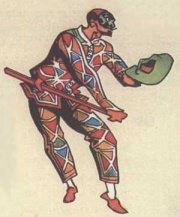Online Encyclopedia
Commedia dell'arte
Commedia dell'arte, (Italian, meaning "comedy of professional artists") was a form of improvisational theater which began in the 16th century and was popular until the 18th century, although it is still performed today. Traveling teams of players would set up an outdoor stage and provide amusement in the form of juggling, acrobatics, and, more typically, humorous plays based on a repertoire of established characters with a rough storyline, called Canovaccio.
Troupes occasionally would perform directly from the back of their traveling wagon, but this is more typical of Carro di Tespi , a sort of travelling theatre that dates back to antiquity.
The performances were improvised around a repertory of stock conventional situations, adultery, jealousy, old age, love, some of which can be traced in Roman comedies of Plautus and Terence. The dialogue and action could easily be made topical and adjusted to satirize local scandals, current events, or regional tastes, mixed with ancient jokes and punchlines. Characters were identified by costume, masks, and even props, such as the slapstick.
Thus, the commedia dell'arte, with its stock situations and stock characters and improvised dialogue, has shown the way to many other forms of drama, from pantomime and Punch and Judy - which features debased forms of the commedia characters (see below) - to the modern animated cartoon, situation comedy, and even professional wrestling. The characters and tropes of the commedia have also been used in modern novels, from sword and sorcery to literary works, notably by Michael Moorcock in his Jerry Cornelius stories that culminate with the Guardian prize-winning The Condition of Muzak.
Male commedia dell'arte characters were depicted by actors wearing masks representing regions or towns. They must always have an erection to symbolize their horny nature. The female characters, however, were usually not masked, hence virgin like. In fact, the roles were often played by males in women's clothing and wigs, in travesti, as it is called.
In some cases, the characters were also traditionally considered as respectively representing some Italian regions or main towns. Often they are still now symbolic of the related town. Following is a list of the original Italian characters, with other English or French names, or descendant characters (in parentheses), and the towns/regions to which they are eventually associated:
- Arlecchino (Harlequin), Venice, an acrobat and clown, he carried a baton which he used to bash other characters, leading to the modern term slapstick. He wore a cat mask, and his ultimate costume, a patchwork of red, green, and blue diamonds is still a fashion motif, though any patchwork costume would be called a harlequin costume. He is a not really villainous, he is just a bit dodgy.
- Brighella (Figaro, Molière's Scapin ), Bergamo, a money-grubbing villain, a partner of Arlecchino
- Columbina (Colombina, the Servant, Columbine, Harlequine, Pierrette), Venice, maidservant to Inamorata and lover of Arlecchino, usually involved in intrigue. She is rather intelligent.
- Il Capitano (the Captain), boastful he-man soldier, but a coward underneath
- Il Dottore (the Doctor), Bologna, Pantalone's friend, and a quack
- Inamorata (the Lover), the leading woman, who wore no mask (see innamorati)
- Inamorato (the Lover), the leading man, who wore no mask (see innamorati)-his partner is also called a lover.
- Isabella (Lucinda, Cornelia, Silvia, Rosaura), Pantalone's daughter. She is very headstrong, flirtatious, sensuous, and articulate. Men are constantly falling hopelessly in love with her. She loves to tease and test the men. Her father always tries to control her life by arranging meetings and agreements with gentlemen suitors.
- Pagliaccio (the Clown), a forerunner of today's clowns
- Pantalone (Pantaloon), Bologna, a rich and miserly merchant who is the father of Isabella. He also employs Arlecchino and treats him cruelly.
- Pedrolino (or Pierino , Vicenza, and most commonly nowadays known as Pierrot a dreamer with a white mask, now considered the French version of a clown.
- Pulcinella, Naples, a hunchback who still chases women, he was the model for Punch in the English variation Punch and Judy.
- La Ruffiana (old woman), usually a mother or gossipy townswoman who intrudes into the lives of the Lovers
- Scaramuccia (Scaramouche), a roguish adventurer and swordsman who replaced Il Capitano in later troupes. Was the servant for another character. He wears a black velvet mask and black trousers, shirt and hat.
- Gianduia, Turin, a well-mannered Piedmontese peasant.
See Carlo Goldoni's A Servant of Two Masters
External links
- The film Scaramouche (1952), based on the novel Scaramouche (1921) by Rafael Sabatini, is about a roguish adventurer and swordsman who hides out in a commedia dell'arte troupe, and features many commedia scenes as well as backstage situations.
- A Thumbnail History of Commedia dell'Arte includes drawings of many of the characters and costumes.
- Character Analysis of Commedia dell'arte

